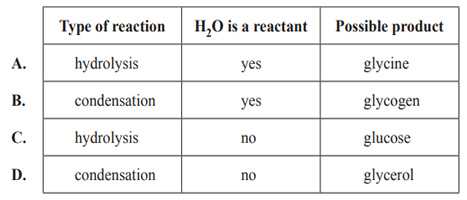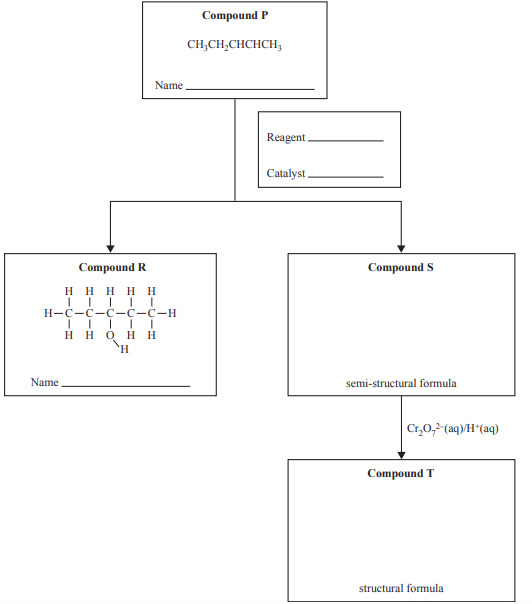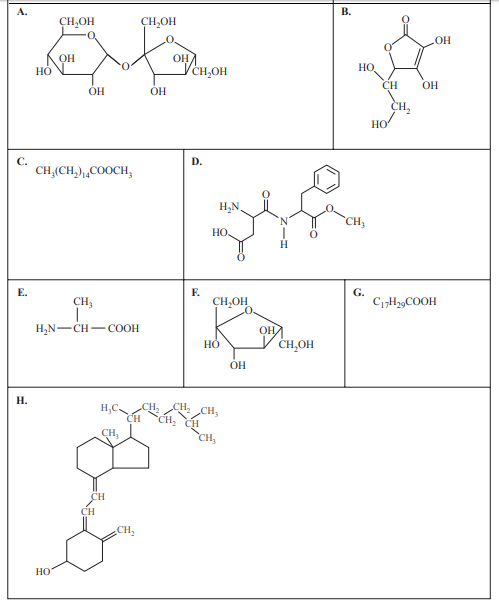1)
a) 
The equation above is an example of what type of reaction?
A. condensation
B. denaturation
C. hydrolysis
D. addition
Solution

b)Pentane, hexane, heptane and octane are non-branched alkanes. Which one of the following statements gives a valid comparison?
A. Octane has a greater viscosity and a higher boiling point than hexane.
B. Pentane has a greater viscosity and a lower boiling point than octane.
C. Heptane has a lower viscosity and a higher boiling point than octane.
D. Heptane has a lower viscosity and a lower boiling point than pentane.
Solution

2) Linoleic acid is a
A. polyunsaturated omega-6 essential fatty acid.
B. monounsaturated omega-3 essential fatty acid.
C. polyunsaturated omega-3 non-essential fatty acid.
D. monounsaturated omega-6 non-essential fatty acid.
Solution

3) Coenzyme A is involved in the synthesis of fatty acids. Coenzyme A is
A. a vitamin that is a precursor of an enzyme.
B. the substrate in the synthesis of fatty acids.
C. required by all enzymes to catalyse a reaction.
D. a small organic molecule that forms a complex with an enzyme.
Solution

4) The semi-structural formula for an isomer of C5H13NO is
NH2CH2CH2CH(CH3)CH2OH The correct systematic name for this molecule is
A. 4-amino-pentan-1-ol
B. 4-amino-2-methyl-butan-1-ol
C. 4-hydroxy-3-methyl-butan-1-amine
D. 1-hydroxy-2-methyl-4-amino-butane
Solution

5) Which one of the following compounds can exist as cis- and trans- isomers?
A. CH2CH2
B. CH2CHCH3
C. CH3CHCHCH3
D. CH3(CH2)16COOH
Solution

6) A meal containing a mixture of carbohydrates, fats and protein is eaten. The biomolecules in this meal are broken down into smaller molecules in the body before they can be absorbed. Which of the following summarises the chemical reactions that would occur prior to the smaller molecules being absorbed by the body?

Solution

7) Tristearin, a triglyceride, is the primary fat found in beef and it contains stearic acid as the only fatty acid. 10.0 g of a pure sample of tristearin is completely broken down into its component molecules – glycerol and stearic acid.
M(tristearin) = 890.0 g/ mol
M(glycerol) = 92.0 g /mol
This reaction would
A. produce 3.10 g of glycerol.
B. require 0.836 L of hydrogen gas.
C. require 0.0112 mol of water molecules.
D. produce 2.03 × 1022 molecules of stearic acid.
Solution

8) Alkenes can be used to manufacture a range of products. The reaction pathway diagram below represents one example of the use of an alkene. In this reaction pathway, Compound P is used to produce Compound R and Compound S. Compound S can then be used to produce Compound T. Complete the following in the appropriate boxes in the reaction pathway diagram provided.
a. Give the IUPAC systematic names for Compound P and Compound R.
b. Write the formulas of the reagent and the catalyst required to produce Compound R and Compound S from Compound P.
c. Write the semi-structural formula of Compound S.
d. Draw the structural formula of Compound T


9) The structures or formulas of a number of important biomolecules are shown on the left. For each of the following characteristics of biomolecules, write the letter or letters in the space provided for the corresponding biomolecule or biomolecules shown on the left. Each biomolecule may be used more than once or may not be used at all..
